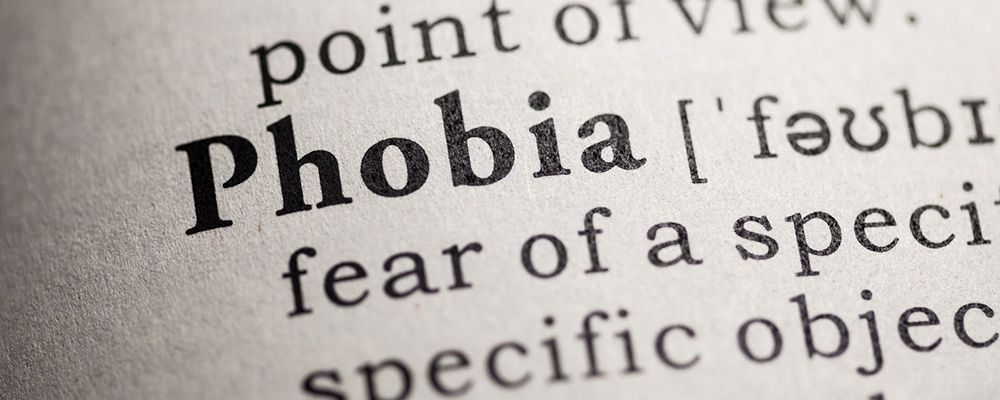

Specific phobia is a diagnosable mental health concern which is characterized by extreme fear of a particular object or situation. This fear causes physical symptoms of anxiety, which can be quite uncomfortable, ranging from hyperventilation, sweating, choking sensation, tachycardia, chest pain/tightness, and shakiness. Additionally, due to this fear, individuals engage in avoidance behaviors that minimize the chances of having to interact with the feared situation. Often, these avoidance behaviors can significantly disrupt one’s life and overall functioning. This disorder has a relatively high prevalence rate, as approximately 5% to 10% of the U.S. population are estimated to have a specific phobia.
The term “phobia” is relatively well known and many words include this phrase to identify specific fears – such as claustrophobia (fear of enclosed spaces) or arachnophobia (fear of spiders). However, the Diagnostic and Statistical Manual of Mental Disorders (DSM-5) identifies five official subtypes of specific phobias. These include: animals, situations, natural environment, blood-injection-injury, and other.
There is not one particular cause of a phobia – instead, risk of developing this disorder is associated with a variety of biological, psychological, and social/environmental factors.
Treatment Considerations
Treatment of specific phobias is incredibly effective and largely uses psychotherapy (i.e., cognitive behavioral therapy with exposure) and, in some cases, medication. However, individuals with phobias are often hesitant to pursue treatment. This is likely attributable to avoidance behaviors inherent to the disorder, as treatment requires individuals to discuss, understand, and face their feared stimuli.
Avoidance of treatment may also relate to feeling embarrassment about this fear, as individuals with phobias are often aware their response is disproportionate. It is important to note that practitioners trained in the mental health field truly understand this disorder and should not show any judgment or criticism – instead, they should demonstrate understanding, empathy, and hope.
Interestingly, treatment may not be recommended for all individuals with specific phobias. The decision to pursue treatment is largely dependent upon the functional impairment associated with this fear. In other words, the extent to which this phobia interferes with one’s daily functioning, distress, and overall quality of life. For example, if an individual reports having a mild phobia related to heights, yet does not have to encounter heights on a regular basis, they may be able to maintain an overall good quality of life without treatment.
Categories of Specific Phobia
When determining one’s functional impairment, it is important to consider the specific fear, one’s personal circumstances, as well as the severity of the phobia itself. See below for a more detailed discussion of the five official phobia subtypes.
Animal-related phobias occur most commonly in relation to spiders, snakes, insects, and dogs. Interestingly, this subtype is generally associated with less functional impairment, as individuals are usually able to effectively avoid particular animals without tremendous disruption of their lives. However, this is not meant to be minimizing, as people with severe phobias will experience significant distress regardless of the feared situation. For example, consider an individual with a phobia of snakes. In general, the avoidance of snakes would not significantly limit one’s life and ability to perform day to day tasks. However, if this phobia is so severe it causes the person to avoid going outside completely, this would obviously have a significant impact on one’s life.


Situational phobias relate to when individuals fear stimuli such as planes, elevators, public transportation, bridges, and enclosed spaces. Research suggests that this type of phobia is one of the most impairing categories (along with the blood injection injury subtype). However, as previously mentioned, the functional limitation associated with these phobias is largely dependent on the actual feared situation, as well as one’s circumstances. For example, if an individual lives in New York City and does not own a car, a phobia of public transportation is going to be incredibly limiting. Alternatively, this same phobia would matter much less if the individual lived in a suburb and largely relied on their own car for transportation.
Phobias relating to the natural environment commonly include fears of storms, water, and heights. When compared to the animal category, this category has been associated with more anxiety, depression, and social problems. However, as mentioned before, the specific level of functional impairment changes depending upon the severity, specific fear, and an individual’s circumstances. For example, an individual with a fear of heights will likely be able to compensate for this using avoidance behaviors and not experience a significant disruption in their routine; however, an individual with a fear of sunlight will have much more difficulty.
The blood injection injury type of phobia occurs when individuals fear needles or invasive medical procedures, such as surgeries. Interestingly, it is estimated that this phobia occurs in 3-4% of the general population. Additionally, this subtype has a relatively large “family tendency,” suggesting that genetics could play a role in its etiology. Regarding functional impairment, this subtype is actually quite concerning, as individuals will often avoid seeking medical assistance and choose not to attend medical appointments. Typically, symptoms of anxiety will often emerge as a result of sitting in a medical clinic or hospital, so individuals are likely to avoid these situations completely. For example, research has reported that between 5% and 15% of the population declines necessary dental treatment due to the fear of oral injections.


Unlike other subtypes, individuals with a blood injection injury phobia often experience a vasovagal response, which can result in fainting at the sight of blood, as well as in anticipation of physical injury or injection. If an individual reports having this response, it can actually change some aspects of treatment. Specifically, when working through exposure therapy, usually individuals are encouraged to practice relaxation strategies to regulate their symptoms of anxiety. Alternatively, individuals with the tendency to faint are actually instructed to tense their bodies (and remain seated) to reduce the risk of fainting.
Lastly, the “other” subtype is perhaps the most generic and heterogeneous, as it includes all other types of phobias that do not fit within the four previous categories. Some common examples of this include fear of vomiting or choking, loud sounds, or costumed characters (e.g., clowns, mascots).
Although there are some differences between these categories, treatment will largely follow a similar format. As mentioned previously, cognitive behavioral therapy with exposure is the most supported approach in addressing this condition; however, in some cases, medication is also implemented. Furthermore, effectiveness of treatment is consistent across the five subtypes, suggesting that these categories do not differ in terms of difficulty to treat. Therefore, regardless of the type of phobia, individuals should feel hopeful about their treatment options.



